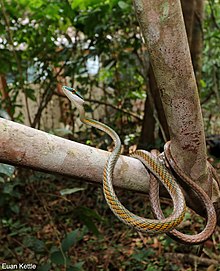Leptophis ahaetulla, commonly known as the lora or parrot snake, is a species of medium-sized slender snake of the family Colubridae.[4] The species is native to Central America and northern South America.[5]
| Leptophis ahaetulla | |
|---|---|

| |
| Scientific classification | |
| Domain: | Eukaryota |
| Kingdom: | Animalia |
| Phylum: | Chordata |
| Class: | Reptilia |
| Order: | Squamata |
| Suborder: | Serpentes |
| Family: | Colubridae |
| Genus: | Leptophis |
| Species: | L. ahaetulla
|
| Binomial name | |
| Leptophis ahaetulla (Linnaeus, 1758)
| |
| Synonyms | |
| |

Geographic range
editIn Central America L. ahaetulla is found in Belize, Costa Rica, El Salvador, Guatemala, Honduras, southern Mexico, Nicaragua, and Panama. In South America it is found in Argentina, Bolivia, Brazil, Colombia, Ecuador, French Guiana, Paraguay, Peru, Trinidad and Tobago, Uruguay, and Venezuela.[2]
Description
editAdults of L. ahaetulla may attain a total length of 172 cm (68 in), which includes a tail 59 cm (23 in) long.[3]
Dorsally, L. ahaetulla is bright green, golden, or bronzy. The keels of the dorsal scales are black or dark brown. The head shields and the dorsal scales may be edged with black. On each side of the head is a black streak which passes through the eye. The upper lip and the belly are white or yellow. The species was thought to be non-venomous,[3] but it is mildly venomous with localized pain, swelling and a feeling of "pins and needles" being the symptoms of envenomation. Symptoms disappear after a few hours.[citation needed]
The head is elongated and distinct from the neck. The eye is large with a round pupil. The body is slender, and the tail is long.[3]
The dorsal scales are arranged in 15 rows at mid-body and are strongly keeled except in the first row on each side (the row adjacent to the ventrals), where they are smooth. They are also smooth on the neck and tail.[3]
The ventrals, which number 151-167, are strongly angulate at the sides. The anal plate is divided. The subcaudals number 140-173, and are divided.[3]
The loreal scale is absent, and the prefrontals extend through the loreal region to contact the upper labials. There are usually 2 postoculars, and the temporals are 1 + 2. There are 8-9 upper labials, of which the 4th & 5th (or 5th & 6th) enter the eye. The anterior chin shields are shorter than the posterior chin shields.[3]
Diet
editL. ahaetulla feeds on small birds and their eggs, lizards, frogs and their eggs, and insects such as grasshoppers.[6] It is also known to show cannibalism and feed on other snakes which is a rare behaviour.[6]
References
edit- ^ Gutiérrez-Cárdenas, P.; Rivas, G.; Nogueira, C.; Gagliardi, G.; Catenazzi, A.; Gonzales, L. (2019). "Leptophis ahaetulla". IUCN Red List of Threatened Species. 2019: e.T197499A2491090. doi:10.2305/IUCN.UK.2019-3.RLTS.T197499A2491090.en. Retrieved 7 August 2024.
- ^ a b Species Leptophis ahaetulla at The Reptile Database . www.reptile-database.org.
- ^ a b c d e f g Boulenger, G.A. (1894). Catalogue of the Snakes in the British Museum (Natural History). Volume II., Containing the Conclusion of the Colubridæ Aglyphæ. London: Trustees of the British Museum (Natural History). (Taylor and Francis, Printers.) xi + 382 pp. + Plates I.- XX. (Leptophis, pp. 105-107; and Leptophis liocercus, pp. 113-114.)
- ^ Lawson, R.; Slowinski, J.B.; Crother, B.I.; Burbrink, F.T. (2005). "Phylogeny of the Colubroidea (Serpentes): New evidence from mitochondrial and nuclear genes" (PDF). Molecular Phylogenetics and Evolution. 37 (2): 581–601. doi:10.1016/j.ympev.2005.07.016. PMID 16172004. S2CID 2509713. Archived from the original (PDF) on 2011-07-27.
- ^ Boos, Hans E.A. (2001). The Snakes of Trinidad and Tobago. College Station, Texas: Texas A&M University Press. ISBN 1-58544-116-3.
- ^ a b "Leptophis ahaetulla (Parrot Snake or Lora)" (PDF). The Online Guide to the Animals of Trinidad and Tobago. UWI.
Further reading
edit- Freiberg M (1982). Snakes of South America. Hong Kong: T.F.H. Publications. 189 pp. ISBN 0-87666-912-7. (Leptophis ahaetulla, pp. 80, 101, 133 + photograph on p. 54.)
- Linnaeus C (1758). Systema naturæ per regna tria naturæ, secundum classes, ordines, genera, species, cum characteribus, differentiis, synonymis, locis. Tomus I. Editio Decima, Reformata. Stockholm: L. Salvius. 824 pp. ("Coluber Ahætulla", p. 225.)
